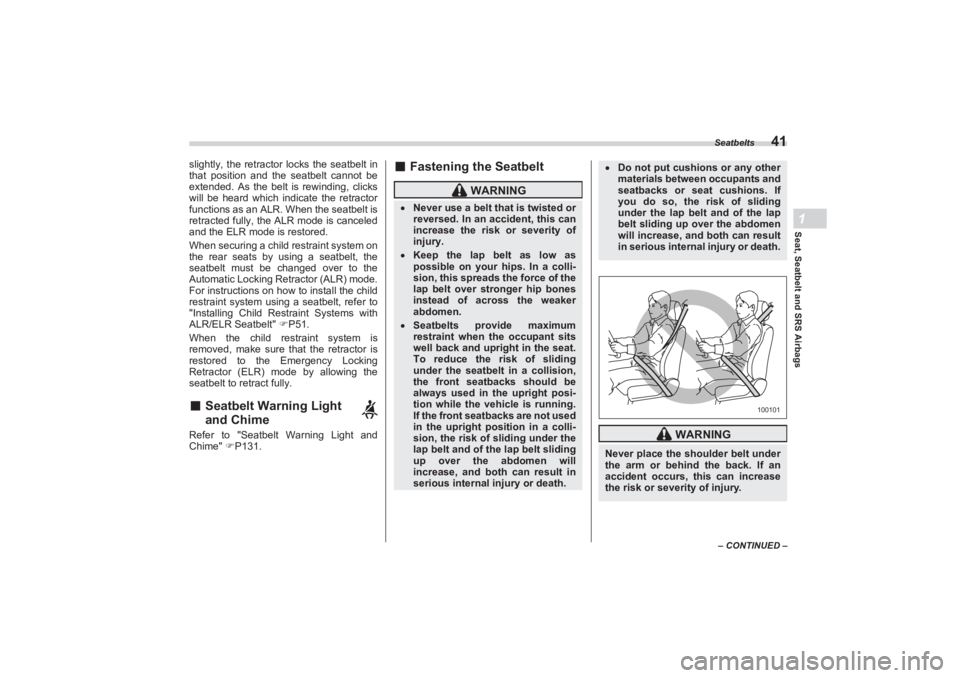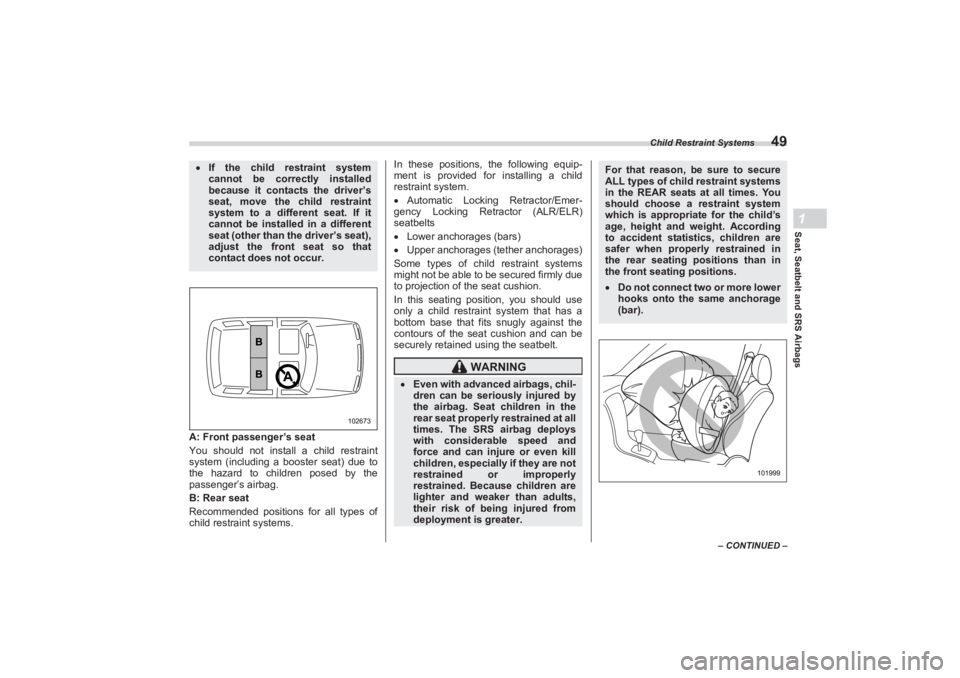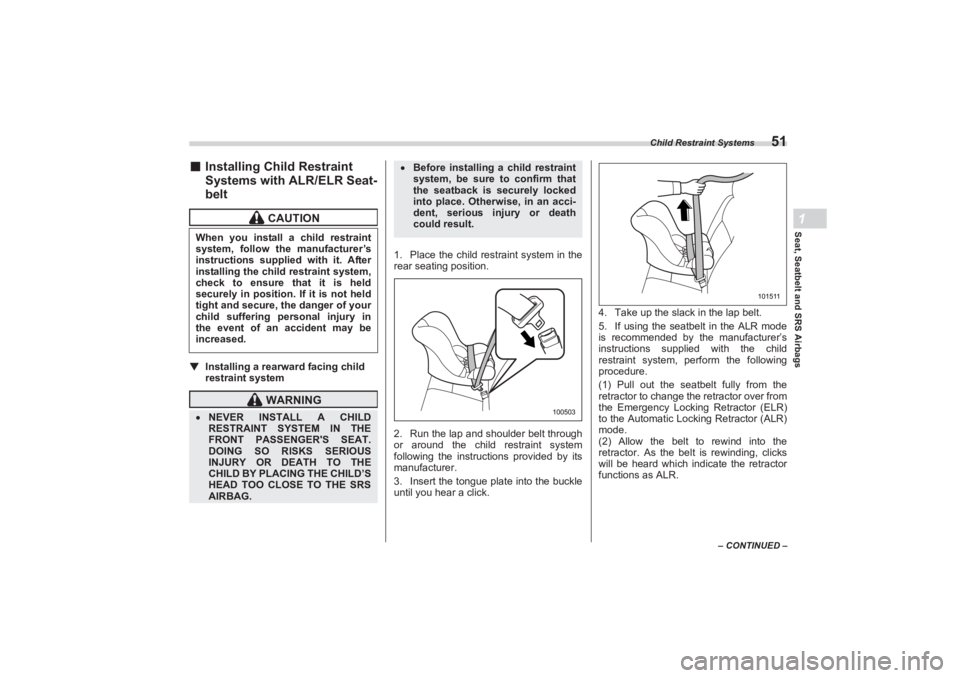2023 SUBARU BRZ lock
[x] Cancel search: lockPage 47 of 432

Seatbelts
41
Seat, Seatbelt and SRS Airbags1
– CONTINUED –
slightly, the retractor locks the seatbelt in
that position and the seatbelt cannot be
extended. As the belt is rewinding, clicks
will be heard which indicate the retractor
functions as an ALR. When the seatbelt is
retracted fully, the ALR mode is canceled
and the ELR mode is restored.
When securing a child restraint system on
the rear seats by using a seatbelt, the
seatbelt must be changed over to the
Automatic Locking Retractor (ALR) mode.
For instructions on how to install the child
restraint system using a seatbelt, refer to
"Installing Child Restraint Systems with
ALR/ELR Seatbelt" P51.
When the child restraint system is
removed, make sure that the retractor is
restored to the Emergency Locking
Retractor (ELR) mode by allowing the
seatbelt to retract fully.■ Seatbelt Warning Light
and Chime Refer to "Seatbelt Warning Light and
Chime" P131.
■ Fastening the Seatbelt
WARNING
Never use a belt that is twisted or
reversed. In an accident, this can
increase the risk or severity of
injury. Keep the lap belt as low as
possible on your hips. In a colli-
sion, this spreads the force of the
lap belt over stronger hip bones
instead of across the weaker
abdomen. Seatbelts provide maximum
restraint when the occupant sits
well back and upright in the seat.
To reduce the risk of sliding
under the seatbelt in a collision,
the front seatbacks should be
always used in the upright posi-
tion while the vehicle is running.
If the front seatbacks are not used
in the upright position in a colli-
sion, the risk of sliding under the
lap belt and of the lap belt sliding
up over the abdomen will
increase, and both can result in
serious internal injury or death.
Do not put cushions or any other
materials between occupants and
seatbacks or seat cushions. If
you do so, the risk of sliding
under the lap belt and of the lap
belt sliding up over the abdomen
will increase, and both can result
in serious internal injury or death.
WARNING
Never place the shoulder belt under
the arm or behind the back. If an
accident occurs, this can increase
the risk or severity of injury.
100101
BRZ_U.book 41 ページ 2022年3月29日 火曜日 午後3時59分
Page 48 of 432

Seatbelts
42▼Front seatbelt guide
To enable the seatbelt to be easily
extended, pass the seatbelt through the
guide. When getting in or out of the rear
seats, release the seatbelt from the guide. ▼
Front seatbelts
1. Adjust the seat position:
Driver’s seat: Adjust the seatback to the
upright position. Move the seat as far from
the steering wheel as practical while still
maintaining full vehicle control.
Front passenger’s seat: Adjust the
seatback to the upright position. Move the
seat as far back as possible.
2. Sit well back in the seat.
3. Pick up the tongue plate and pull the
belt out slowly. Do not let it get twisted.
If the belt stops before reaching the
buckle, return the belt slightly and pull
it out more slowly.
If the belt still cannot be unlocked,
let the belt retract slightly after giving it
a strong pull, then pull it out slowly
again. 4. Insert the tongue plate into the buckle
until you hear a click.
5. To tighten the lap part, pull up on the
shoulder belt.
6. Place the lap belt as low as possible
on the hips, not on the waist.
CAUTION
Metallic parts of the seatbelt can
become very hot in a vehicle that
has been closed up in sunny
weather; they could burn an occu-
pant. Do not touch such hot parts
until they cool.
102672
100102
100103
BRZ_U.book 42 ページ 2022年3月29日 火曜日 午後3時59分
Page 49 of 432

Seatbelts
43
Seat, Seatbelt and SRS Airbags1
– CONTINUED –
▽Unfastening the seatbelt1) Button1. Push the button on the buckle.
2. Retract the seatbelt slowly to prevent it
from getting tangled or twisted.
Before closing the door, make sure that
the belts are retracted properly to avoid
catching the belt webbing in the door.
▼ Rear seatbelts
1. Sit well back in the seat.
2. Pick up the tongue plate and pull the
belt out slowly. Do not let it get twisted.
If the belt stops before reaching the
buckle, return the belt slightly and pull
it out more slowly.
If the belt still cannot be unlocked,
let the belt retract slightly after giving a strong pull on it, then pull it out slowly
again.
3. Insert the tongue plate into the buckle
until you hear a click.
4. To tighten the lap part, pull up on the
shoulder belt. 5. Place the lap belt as low as possible
on the hips, not on the waist.
▽Unfastening the seatbelt
1) Button1. Push the button on the buckle.
2. Retract the seatbelt slowly to prevent it
from getting tangled or twisted.
Before closing the door, make sure that
the belts are retracted properly to avoid
catching the belt webbing in the door.■ Seatbelt MaintenanceTo clean the seatbelts, use a mild soap
and lukewarm water. Never bleach or dye
the belts because this could seriously
affect their strength.
102492
1
100102100103
102492
1
BRZ_U.book 43 ページ 2022年3月29日 火曜日 午後3時59分
Page 51 of 432

Seatbelt Pretensioners
45
Seat, Seatbelt and SRS Airbags1
– CONTINUED –
When you sell your vehicle, we urge
you to inform the bu yer that the vehicle
is equipped with seatbelt
pretensioners. Also, notify the buyer of
the contents in this section.■ Front seatbelt with Shoulder
Belt PretensionerThe pretensioner sensor also serves as
follows.
Front impact sensor
Side impact sensor
Rollover sensor
If the sensor detects a certain predeter-
mined amount of force during frontal or
side collisions or rollover accidents, any
seatbelt that has a se atbelt pretensioner is
quickly drawn back in by the retractor to take up the slack so
that the belt more
effectively restrains the seat occupant.
The front seatbelt pretensioner includes a
tension reducing device which limits the
peak forces exerted by the seatbelt on the
occupant in the event of a collision. The
front passenger's side adaptive force
limiter will select a reducing load to suit the
body size of the occupant as detected by
the occupant detection sensor.
When a seatbelt pretensioner is activated,
an operating noise will be heard and a
small amount of smoke will be released.
These occurrences are normal and not
harmful. This smoke does not indicate a
fire in the vehicle.
Once the seatbelt pretensioner has been
activated, the seatbelt retractor remains
locked. Consequently, the seatbelt cannot
be pulled out and retracted and therefore
must be replaced.
■ System MonitorsA diagnostic system continually monitors
the readiness of the seatbelt pretensioner
with the ignition switch in the “ON” posi-
tion. The seatbelt pr etensioners share the
control module with the SRS airbag
system. Therefore, if any malfunction
occurs in a seatbelt pretensioner, the SRS
airbag system warning light will illuminate. For details, refer to "SRS Airbag System
Monitors" P87.
■ System Servicing
100121
WARNING
When discarding a seatbelt
retractor assembly or scrapping
the entire vehicle damaged by a
collision, consult your SUBARU
dealer. Tampering with or disconnecting
the system’s wiring could result
in accidental activation of the
seatbelt pretensioner and/or SRS
airbag or could make the system
inoperative, which may result in
serious injury. Do not use elec-
trical test equipment on any
circuit related to the seatbelt
pretensioner and SRS airbag
systems. For required servicing
of the seatbelt pretensioner,
consult your nearest SUBARU
dealer.
CAUTION
For the locations of the sensors and
control modules, refer to "Compo-
nents" P68.
BRZ_U.book 45 ページ 2022年3月29日 火曜日 午後3時59分
Page 53 of 432

Child Restraint Systems
47
Seat, Seatbelt and SRS Airbags1
– CONTINUED –
Children could be endangered in an acci-
dent if their child restraint systems are not
properly secured in the vehicle. When
installing the child re straint system, care-
fully follow the manufacturer’s instruc-
tions.
According to accident statistics, children
are safer when properly restrained in the
rear seating positions than in the front
seating positions.
All U.S. states and Canadian provinces
require that infants and small children be
restrained in an approved child restraint
system at all times while the vehicle is
moving.Lock release button
1) Unlocked
2) Locked
A) Unlocking marker in red
A
12
102671
WARNING
Before installing a child restraint
system, be sure to confirm that
the seatback is securely locked
into place. Otherwise, in an acci-
dent, serious injury or death
could result. Do not leave children in the car
unattended. High interior
temperatures may cause heat
stroke and dehydration that
result in serious injury or death.
100125
WARNING
Never let a passenger hold a child
on his or her lap or in his or her
arms while the vehicle is moving.
The passenger cannot protect the
child (or infant) from injury in a col-
lision, because the child will be
caught between the passenger and
objects inside the vehicle. Addition-
ally, holding a child in your lap or
arms in the front seat exposes that
child to another serious danger.
Since the SRS airbag deploys with
considerable speed and force, the
child could be injured or even killed.
100126
BRZ_U.book 47 ページ 2022年3月29日 火曜日 午後3時59分
Page 55 of 432

Child Restraint Systems
49
Seat, Seatbelt and SRS Airbags1
– CONTINUED –
A: Front passenger’s seat
You should not install a child restraint
system (including a bo oster seat) due to
the hazard to children posed by the
passenger’s airbag.
B: Rear seat
Recommended positions for all types of
child restraint systems. In these positions, the following equip-
ment is provided for installing a child
restraint system.
Automatic Locking Retractor/Emer-
gency Locking Retractor (ALR/ELR)
seatbelts
Lower anchorages (bars)
Upper anchorages (tether anchorages)
Some types of child restraint systems
might not be able to be secured firmly due
to projection of the seat cushion.
In this seating position, you should use
only a child restrain t system that has a
bottom base that fits snugly against the
contours of the seat cushion and can be
securely retained using the seatbelt. If the child restraint system
cannot be correctly installed
because it contacts the driver’s
seat, move the child restraint
system to a different seat. If it
cannot be installed in a different
seat (other than the driver’s seat),
adjust the front seat so that
contact does not occur.
102673
WARNING
Even with advanced airbags, chil-
dren can be seriously injured by
the airbag. Seat children in the
rear seat properly restrained at all
times. The SRS airbag deploys
with considerable speed and
force and can injure or even kill
children, especially if they are not
restrained or improperly
restrained. Because children are
lighter and weaker than adults,
their risk of being injured from
deployment is greater.
For that reason, be sure to secure
ALL types of child restraint systems
in the REAR seats at all times. You
should choose a restraint system
which is appropriate for the child’s
age, height and weight. According
to accident statistics, children are
safer when properly restrained in
the rear seating positions than in
the front seating positions. Do not connect tw o or more lower
hooks onto the same anchorage
(bar).
101999
BRZ_U.book 49 ページ 2022年3月29日 火曜日 午後3時59分
Page 57 of 432

Child Restraint Systems
51
Seat, Seatbelt and SRS Airbags1
– CONTINUED –
■Installing Child Restraint
Systems with ALR/ELR Seat -
belt▼ Installing a rearward facing child
restraint system
1. Place the child rest raint system in the
rear seating position.
2. Run the lap and shoulder belt through
or around the chil d restraint system
following the instructions provided by its
manufacturer.
3. Insert the tongue plate into the buckle
until you hear a click. 4. Take up the slack in the lap belt.
5. If using the seatbelt in the ALR mode
is recommended by the manufacturer’s
instructions supplied with the child
restraint system, perform the following
procedure.
(1) Pull out the seatbelt fully from the
retractor to change the retractor over from
the Emergency Locking Retractor (ELR)
to the Automatic Locking Retractor (ALR)
mode.
(2) Allow the belt to rewind into the
retractor. As the belt is rewinding, clicks
will be heard which indicate the retractor
functions as ALR.
CAUTION
When you install a child restraint
system, follow the manufacturer’s
instructions supplied with it. After
installing the child restraint system,
check to ensure that it is held
securely in position. If it is not held
tight and secure, the danger of your
child suffering personal injury in
the event of an accident may be
increased.
WARNING
NEVER INSTALL A CHILD
RESTRAINT SYSTEM IN THE
FRONT PASSENGER'S SEAT.
DOING SO RISKS SERIOUS
INJURY OR DEATH TO THE
CHILD BY PLACING THE CHILD’S
HEAD TOO CLOSE TO THE SRS
AIRBAG.
Before installing a child restraint
system, be sure to confirm that
the seatback is securely locked
into place. Otherwise, in an acci-
dent, serious injury or death
could result.
100503
101511
BRZ_U.book 51 ページ 2022年3月29日 火曜日 午後3時59分
Page 58 of 432

Child Restraint Systems
526. Before having a child sit in the child
restraint system, try to move it back and
forth and right and left to check if it is firmly
secured. Sometimes a child restraint
system can be more firmly secured by
pushing it down into the seat cushion and
then tightening the seatbelt. It should not
be possible to move the child restraint
system more than 1 in (2.5 cm) in any
direction along the seatbelt path.
7. If the seatbelt has been set to the ALR
mode in step 5, pull at the shoulder portion
of the belt to confir m that it cannot be
pulled out (ALR properly functioning). 8. To remove the child restraint system,
press the release button on the seatbelt
buckle and allow the belt to retract
completely. The belt will return to the ELR
mode.
NOTEWhen the child restraint system is no
longer in use, remove it and restore
the ELR function of the retractor. That
function is restored by allowing the
seatbelt to retract fully.
▼ Installing a forward facing child
restraint system
102819
100506
WARNING
NEVER INSTALL A CHILD
RESTRAINT SYSTEM IN THE
FRONT PASSENGER’S SEAT.
DOING SO RISKS SERIOUS
INJURY OR DEATH TO THE
CHILD BY PLACING THE CHILD’S
HEAD TOO CLOSE TO THE SRS
AIRBAG. Before installing a child restraint
system, be sure to confirm that
the seatback is securely locked
into place. Otherwise, in an acci-
dent, serious injury or death
could result.
BRZ_U.book 52 ページ 2022年3月29日 火曜日 午後3時59分